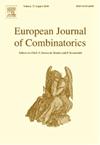Extensions and applications of the Tuza-Vestergaard theorem
IF 0.9
3区 数学
Q1 MATHEMATICS
引用次数: 0
Abstract
The transversal number of a hypergraph is the minimum number of vertices that intersect every edge of . A 6-uniform hypergraph has all edges of size 6. On 10 November 2000 Tuza and Vestergaard (2002) conjectured that if is a 3-regular 6-uniform hypergraph of order , then . This conjecture was recently proven by the Henning and Yeo (2023) and is now called the Tuza-Vestergaard Theorem. In this paper we extend the Tuza-Vestergaard Theorem by relaxing the 3-regularity constraint and allowing bounded maximum degree 4. We present several applications of the Tuza-Vestergaard Theorem and its extension. We obtain best known upper bounds to date on the transversal number of a (general) 6-uniform hypergraph of order and size . In particular, if is a 4-regular 6-uniform hypergraph of order , then we show that . The Tuza constant is defined by , where the supremum is taken over the class of all 6-uniform hypergraphs . Since 1990 the exact value of has yet to be determined. We show that , where is conjectured to be the correct bound. Moreover we show that if is a graph of order with , then , where denotes the total domination number of and is conjectured to be the correct bound. These bounds improve best known bounds to date.
tuza - vesterggaard定理的扩展与应用
超图H的截线数τ(H)是与H的每条边相交的最小顶点数。一个6-均匀超图的所有边的长度为6。2000年11月10日,Tuza和vesterggaard(2002)推测,如果H是一个n阶的3-正则6-一致超图,则τ(H)≤14n。这个猜想最近被Henning和Yeo(2023)证明,现在被称为tuza - vesterggaard定理。本文通过放宽3正则约束并允许有界最大次4,扩展了tuza - vesterggaard定理。给出了tuza - vesterggaard定理及其推广的几个应用。我们得到了大小为m的n阶(一般)6-均匀超图H的截数的已知上界。特别地,如果H是n阶的4-正则6-均匀超图,则我们证明了τ(H)≤27n。图萨常数c6定义为c6=supτ(H)n(H)+m(H),其中,所有6-一致超图H的类都取至极值。自1990年以来,c6的确切值尚未确定。我们证明了16≤c6≤16+1210,其中c6=16被推测为正确的界。进一步证明了如果G是n阶图且δ(G)≥6,则γt(G)≤413+6217n,其中γt(G)表示G的总支配数,推测γt(G)≤413n为正确界。这些边界改进了迄今为止最知名的边界。
本文章由计算机程序翻译,如有差异,请以英文原文为准。
求助全文
约1分钟内获得全文
求助全文
来源期刊
CiteScore
2.10
自引率
10.00%
发文量
124
审稿时长
4-8 weeks
期刊介绍:
The European Journal of Combinatorics is a high standard, international, bimonthly journal of pure mathematics, specializing in theories arising from combinatorial problems. The journal is primarily open to papers dealing with mathematical structures within combinatorics and/or establishing direct links between combinatorics and other branches of mathematics and the theories of computing. The journal includes full-length research papers on important topics.

 求助内容:
求助内容: 应助结果提醒方式:
应助结果提醒方式:


